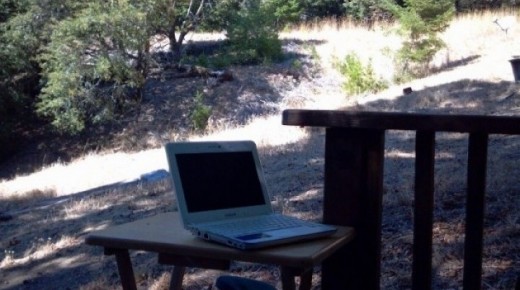The electrical system powered by a couple of car batteries in parallel, with lighting provided by 12-volt bulbs is strung throughout. A simple charge circuit, driven by an array of solar panels up in the meadow on the hillside, keeps the batteries charged, and there’s a small hand-start generator for backup. With judicious use of power in the summer, so long as you topped up the car batteries with distilled water occasionally, you would probably have enough power to read by for a few hours each night without using the generator. In the rainy winter and spring months, a micro-hydro unit would provide sufficient top-up charge. There is no TV — only a radio, tuned to KHUM, and a CB radio, so that some warning could be had of fire outbreaks. There’s no phone. All of the power-related items — the charge circuit, the fuse boxes, the meters, the generator — are housed in a nearby shed resembling an outhouse, covered with redwood shingles.
Some of the neighbors had built their homes to include a more complex power system, complete with an inverter and 110 VAC sockets. One of these enterprising folks ran a software label from his house, and there I meet my first IBM PC, falling in love with the flight simulator. But this neighbor’s pride and joy is an Apple Lisa. I remember my dad painstakingly drawing on the Lisa one night when it crashed with the annoying bomb icon and, perplexed, exclaiming, “I didn’t draw that!”
I’m standing outside at night in the perfect darkness, in a clearing next to the house, up by the solar panels, craning my neck upwards and marveling at the Milky Way overhead, planets, satellites, meteors. I’ve hardly ever had the opportunity to see these things before in light-polluted suburban England. The summer crickets and cicadas are loud and alien to my ears. All around in the forest, things rustle and squeak and snort, eyes occasionally reflecting back at me in blue, red, or green when I fitfully shine my flashlight at them.
Solar power (or, more precisely, photovoltaic power) was a relatively recent commercial product in 1984, made possible by the same semiconductors that powered my beloved computers. A local entrepreneur, David Katz, had started Alternative Energy Engineering five years before, and my dad was working there part time. Katz, a former Department of Defense employee, was also a back-to-the-land migrant in the late 70s. At the 1980 Consumer Electronics Show in Las Vegas, Katz came across a guy in a booth selling solar-powered toys. More interested in the solar panels than the toys, he persuaded the bemused booth owner to sell him 100 panels right there. Back in Northern California, Katz sold them all in two days. It was fascinating to me that the energy was, apart from the cost of the solar panels themselves, free.
I go back to England at the end of the summer, not to return to Humboldt County again for 14 years. In the meantime, the house in the forest gains several extensions, on two levels, and a beautiful Jøtul wood-burning stove. The power system grows more complex, with an Outback inverter and charge controller, and more solar panels. A phone line is installed with 3,000 feet of armored cable rolled out from the neighbor’s house, where the phone company junction box sits. A new bathroom is added in time for a family reunion in 2000. A studio is built for my dad at the bottom of the driveway. Propane heaters go in. Then, a propane tank, and an 8.5 kilowatt Kohler generator to replace the little hand-started one. Three 2,500 gallon storage tanks are added to keep water flowing in the dry summer months and provide water in the event of fire. A cabin is built next to the house in 2005, insulation is added throughout, and the whole thing gets a snazzy burgundy and blue paint job. A covered carport goes up shortly after that.
When I moved from Paris to live in California in 2009, the house I came to was very different to the little cabin I first saw 25 years earlier. I spent a few months there, before getting a job in San Francisco writing software for a medical device company. I visited occasionally, but it wasn’t until July 2012 that I became a permanent resident out in the Wired Woods.
A difference of opinion at work leads me to a practical appreciation of the difference between European and American employer/employee relations, a new career as a telecommuting consultant beckons, and I set my mind to inventing technology for off-grid seniors in the next gripping installment.



Comments are closed.